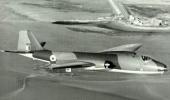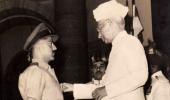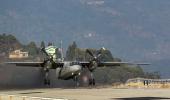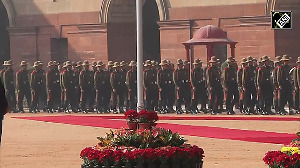The sortie had to be executed in good weather and in sub-zero temperatures, which meant it was to be accomplished by mid or third week in May before the earth heated up and the monsoon clouds made things difficult.

Air Vice Marshal Suryakant Chafekar had a long-standing dream -- to land a machine at the world's highest airfield -- Daulat Beg Oldi -- an old disused advanced landing ground situated near the northern-most part of Kashmir.
"He was barely 18 or 19, already donning an ITBP (Indo-Tibetan Border Police) uniform and getting baptised at Daulat Beg Oldi. He kept following me as I went about checking the hardness of the soil using a screwdriver along the packed-mud runway that had been made in record time to facilitate our landing," Air Vice Marshal Suryakant Chafekar, AVSM, Shaurya Chakra, now a seasoned veteran settled in Nagpur, recalls in a telephone conversation with Air Commodore Nitin Sathe (retd).
The ITBP trooper was rather intrigued by then Group Captain Chafekar's repeated trips to the world's highest advanced landing ground over the past few weeks in a helicopter.
'Aap kab aane waale ho apne jahaj mein, Sir?' (When will you come in your aeroplane sir?), the ITBP trooper asked, not hiding his curiosity of seeing a fixed wing aeroplane land at his base, where he stood guard, barely a few kilometres from the Karakoram Pass.
A dilapidated shell of a crashed Mi-4 helicopter, painted white, has served as a beacon in the brown and muddy background of the bowl of land that accommodates the airfield.
The shell also served as a cafeteria for visitors now, and had its own story to tell.
It was in the late 1970s when the Mi-4 was the work horse of the Indian Air Force operating at these dizzy heights supplying the army with much needed rations.
While it offloaded its cargo on the runway, a Fairchild 'Packet' aircraft had zoomed in overhead and disgorged a load of atta and daal which came floating down on parachutes.
One of the parachutes along with its load had landed directly on top of the running rotors of the helicopter, destroying it instantly.
Thankfully, there was no loss of life and the shell was left there to weather away in the cold and dry climate at 16,700 feet.

'Hum jaroor aayenge, aur jaldi aayenge (we will surely come, and soon)', 'Chafe -- as the AVM is known in the IAF -- told the young ITBP trooper.
'Aur jab hum aayenge, aap wahan par khade hona aur hame jaroor milna! (And when we come, you stand there and meet us,' Chafe added, pointing to a vantage point next to the end of the runway.
He was then a Group Captain and the Commanding Officer of 48 Squadron based at Chandigarh.
Chafe had taken over the reins of the squadron on New Year's Day 2008.

Interestingly, on the same day, Air Marshal Pranab Kumar Barbora had taken over as Commander in Chief of the Western Air Command, the most operational and 'happening' command in the Indian Air Force.
Air Marshal and Group Captain were soon to be involved in one of the most challenging missions -- landing an AN-32 aeroplane way beyond its operational limits at the world's highest advanced landing ground.
The C-in-C was on his familiarisation visit to the squadron soon after taking over when Group Captain Chafekar briefed him about his dream of landing the machine at Daulat Beg Oldi.
Having served in Chandigarh earlier and being experienced in the area, he was convinced in his mind that it was possible to put down the machine there safely.

An attempt had been made in 2002 and two pilots from the squadron were taken for a reccee in a Mi-26 helicopter.
While conducting an inspection of the ground at the Daulat Beg Oldi advanced landing ground, the crew had noticed a large crater almost 15 to 20 feet long across the runway, probably caused by an earthquake that had jolted the area a few years ago.
The crater required engineering effort with use of heavy equipment to be filled up.
Nevertheless, despite the plan being abandoned, a Mi-26 helicopter was tasked to deliver some heavy equipment to the area so that work on filling the crater could continue.
For helicopter pilots like me flying over the area, one would always wonder why could we not land a transport aircraft on this massive airstrip in the middle of nowhere.
While discussing the purpose it would serve, we spoke about showing our strength to the Chinese, increasing our ability to augment troops in case of trouble, and the ability to door deliver rations and war fighting capability to our troops stationed there.
The argument would thereafter veer to the fact that we would end up disturbing the peace and tranquillity on the border.
Why do it when you can avoid it was the oft question asked which ended the discussions.
Air Vice Marshal Chafekar gave me further insights into the reason for IAF aircraft not landing there for 43 years.
He told me that three boards of officers had been commissioned to suggest how and why the Daulat Beg Oldi advanced landing ground should be made operational.
All the three boards were headed by senior air force officers who had suggested that the An-32 aircraft should not be operated at the Daulat Beg Oldi advanced landing ground because:-
- Firstly, the height and temperature conditions would entail landing the machine at above the specified parameters given in the flight manuals and therefore would be dangerous to man and machine.
- Secondly, the airfield was too close to the border and one small mistake in navigation would cause an inadvertent air violation leading to further problems on the diplomatic front.
- Thirdly, should the An-32 require to switch off there, there was almost no way that it could be recovered back for flying in one piece. Even a small technical problem like a tyre burst or deflation could make things very very difficult.
- Fourthly, the soil expert had ruled that the surface of the Daulat Beg Oldi runway wasn't fit enough to take the load of a 17-odd ton aircraft landing at 280 kmph.
- Finally, it was too close to the China border and therefore government sanction may not be given at all to attempt the same.
Chafekar explained that all the arguments by the staff at the Western Air Command headquarters suggested that the mission must not be attempted till such time we had a suitable aircraft like the present day four engine C-130 with us.
At one such meeting in Delhi at the Western Air Command HQ, Air Marshal Barbora decided to attend.
As the presentation wore on, the air marshal grew visibly irritated.
'Guys!' the air marshal said, 'I want to know from you how the mission can be done and not how we cannot do it!'
'Chafe!' the air marshal called out from his sofa in the front. 'Hoga ki nahi hoga? (Will it happen or not?) he asked.
'Hoga sir!' was Group Captain Chafekar's immediate response.
The C in C got up and turned around to address the meeting.
'Gentlemen,' Air Marshal Barbora declared, 'We are going ahead with the mission. Leave the date and details to Chafe. I will now deal with this directly.'
The meeting ended and a happy Group Captain Chafekar went back to Chandigarh to plan and train for the same.
There was very little time.
The sortie had to be executed in good weather and in sub-zero temperatures which meant that it was to be accomplished by the mid or third week in May before the earth heated up and the monsoon clouds made things difficult.
Part 2: Mission Accomplished - When IAF Made History
Veteran Air Commodore Nitin Sathe is a helicopter pilot who served the Indian Air Force for 35 years and was part of United Nations Peace Keeping Force operations in the Congo.
Production: Ashish Narsale/Rediff.com











